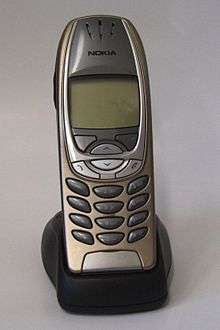Nokia 6310i
 Nokia 6310i in DCH-9 charging dock | |
| Manufacturer | Nokia |
|---|---|
| Compatible networks | Tri band GSM / GPRS, GSM 900, GSM 1800, GSM 1900 |
| Availability by country | 2002–2005 |
| Predecessor | Nokia 6210 |
| Successor | Nokia 6600 |
| Form factor | Candybar |
| Dimensions | 129 × 47 × 21 mm |
| Weight | 111 g (3.9 oz) |
| Memory | 174 kB |
| Battery | BPS-2, (Lithium-ion polymer battery, 1100 mAh), up to 408 hours on standby, 7 hours talk time.[1] |
| Data inputs | Keypad |
| Display | Monochrome display, 96×65 pixel |
| Connectivity | Serial Cable, Bluetooth, InfraRed |
The Nokia 6310i is a mobile phone from Nokia first introduced at the CeBIT fair in March 2002 with sales starting later that year and discontinued in late 2005. It was primarily marketed as a business phone and for some years was the dominant GSM device in the corporate world. The device was most commonly offered in Two-tone Silver/Grey or Two-tone Gold/Black trim, the Copper coloured variant being much rarer.
The model is basically the same as the earlier 6310 from 2001, with the addition of tri-band reception, Java and a blue-backlit LCD Screen (as opposed to the earlier green backlighting).
It was the successor to the 6310 (2001) and 6210 (2000) which themselves were preceded by the 6150 (1998) and 6110 (1997). Accessories (such as batteries) can generally be swapped between all these models.
This phone has been (and still is)[2] very popular for its robustness, simplicity and long battery life years after being discontinued as a product.[3]
Like the 6210 and 6310, the 6310i was optionally included on several Mercedes-Benz cars.[4] A cradle was installed in the dashboard, into which the phone was securely placed. Connectors in the cradle provided the phone with electrical power, routed the audio path through the car's audio system, and an external antenna mounted on the car's chassis replaced the internal antenna, providing a stronger signal and better signal-to-noise ratio.
Features
- E-mail, text and picture messages
- GPRS
- HSCSD
- The first Nokia phone after the 6310 to have integrated Bluetooth
- IrDA
- WAP 1.2.1
- Java applications
Java
This phone supports the following Java APIs:
- CLDC 1.0
- MIDP 1.0
- Nokia UI API
References
- ↑ "Retro: Nokia 6310i". Mobile Gazette. 2008-10-15.
- ↑ http://www.entrepreneur.com/article/230305
- ↑ Nokia wins hearts, minds with breakthrough mobile, Andrew Orlowski, The Register, 20 December 2007.
- ↑ http://www.chip.de/artikel/Nokia-6310-und-Mercedes-Freisprecher_30587899.html